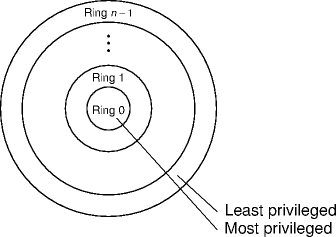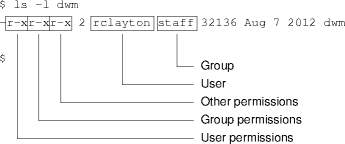Operating Systems Lecture Notes
2014 December 2 • Security Mechanisms
Outline
System Model
- An object is defined by the set of operations it
supports.
- Every object is distinct from all other objects, its identity.
- One object, the calling object, invokes an operation provided
by another object, the called object.
- The caller and called object are distinct.
- A system is a dynamic set of objects.
Objective
- Characterize the desirable operation invocations between objects.
- Advanced objective: among objects.
- This characterization is the security policy.
- Make sure all operation invocations in the system are desirable.
What For?
- Two obvious characterizations:
- Nothing is permitted (just say no).
- Everything is permitted (just say yes).
- Characterization 1 is simple and useless.
- Characterization 2 is as simple and useful. What's wrong with it?
- It doesn't map well to peoples' world view.
- No notions of authorization and access.
Policy and Mechanism
- System objectives:
- Promote desirable behavior.
- Prevent undesirable behavior.
- Policy defines desirable and undesirable behavior: the what.
- Mechanism implements promoting and preventing: the how.
- This is a lecture on mechanism.
Access Matrix
- View protection as an access matrix.
- Rows represent domains.
- Columns represent objects.
- access(i, j) is the set of operations that a process in domain i can invoke on object j.
Access Matrix Use
- A process in domain i can invoke op on object j if op ∈ access(i, j).
- The creator of object j defines the entries in column j.
- Statically at column creation time.
- Dynamically during object lifetime.
Dynamic Rights Assignment
- An access-matrix element has add and remove operations.
- An associated domain: owner of object i.
- Special access rights:
- Owner of object i.
- Copy op from object i to object j.
- Modify domain i access rights.
- Transfer from domain i to domain j.
Access Matrix Observations
- Mechanism and policy are separate.
- Mechanisms: the access matrix in use.
- Policy: what's in the access matrix.
- Access matrices don't solve the general confinement problem.
Domains
- Sets of calling objects may exhibit similar or identical invocation patterns.
- Abstract those patterns into domains.
- Replace calling-object rows with domain rows.
- N common rows collapse into a single row.
- Associate calling objects with domains.
- The domain-object relation is another object for the access matrix.
Implementation
- A large sparse matrix.
- Large: all objects × all domains.
- Sparse: most domains don't care about most objects.
A Matrix Implementation
- Is (domain i, object j, R) in the table?
- Is op ∈ R?
- What can a domain do? What does an object allow?
ACL Example
- Can domain i perform op on object i?
- Is (domain i, object j, R) in object j's ACL?
- Is op ∈ R?
- Is op ∈ M, the default rights set?
Column-Based Implementation
- Each column implemented as an domain permissions list for an object.
- Called an capability.
- A compact list of (object, rights) pairs.
Row-Based Implementation
- Each row implemented as an object rights list for a domain.
- Called a capability
- Can domain i perform op on object i?
- Is (object j, R) in domain i's capability?
- Is op ∈ R?
Blob-Based Implementation
- A small number of rights sets per object over all domains.
- Assign each rights set a lock bit pattern.
- An interested domain is assigned one of the locks as a key.
- Can domain i perform op on object i?
- Is domain i's key k one of object j's locks?
- Is op in the rights set associated with k?
MULTIX Protection
- MULTIX was a 1970s large-scale OS project.
- A set of pre-defined domains Di for 0 ≤ i ≤ n.
- Lower indexed rings are more privileged than higher indexed rings.
- Di ⊂ Dj when i > j.
- Ring 0 is most privileged.
- Not only domains, but relations between domains.
MULTIX Illustrated

Unix Protection
- Unix has three protection domains: user, group, and
other.
- Every user is sole occupant of their user domain.
- Every user is in one of a set of group domains.
- A user may move among groups in the set, and add and remove group members.
- Every user is in the other domain.
Unix Protection Objects
- Files are the basic protection objects.
- Unix tries to make everything look like a file.
- Operations are read, write and execute.
- Suitably re-interpreted.
- Files are tagged with user (owner) and group domains (one of each).
- Each domain has appropriate read-write-execute permissions set.
Unix Example

Summary
References
- HYDRA: The Kernel of a Multiprocessor Operating System by William Wulf, E. Cohen, W. Corwin, Anita Jones, R. Levin, C. Pierson and F. Pollack in Communications of the ACM, June, 1974.
| This page last modified on 2011 October 9. |
